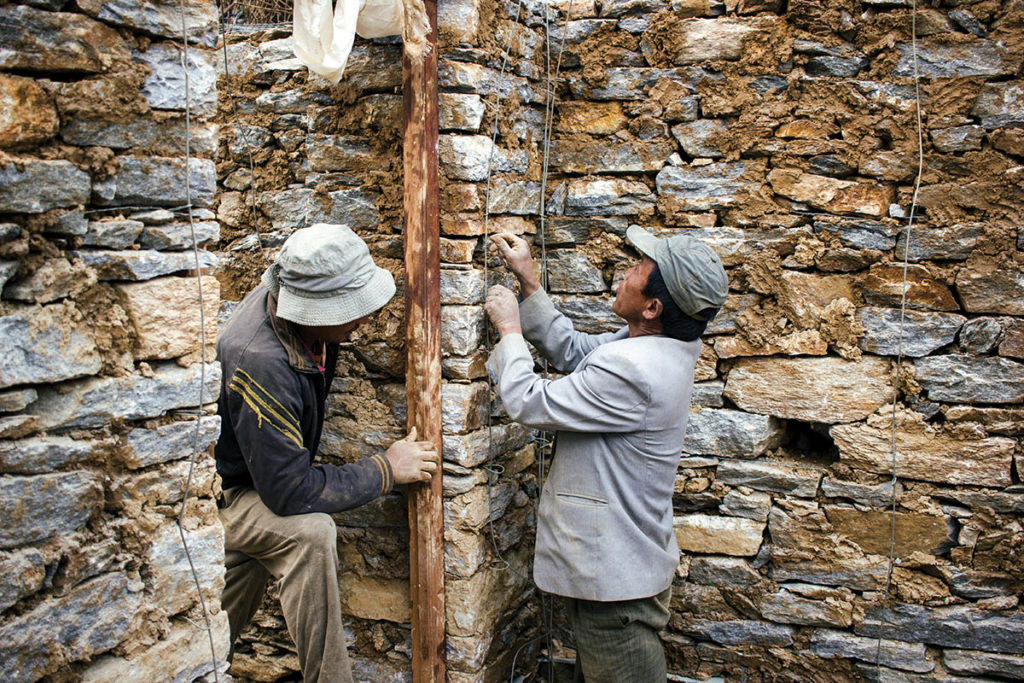Containment reinforcement: Other applications
June 15, 2022

Containment reinforcement technology was first used by Hunnarshala in reconstruction efforts after the Kachchh earthquake of 2001. At the time, they built 400 homes with 6-millimetre mild steel bars outside the stone masonry with mud mortar and RCC bands.
“UNDP was working with Abhiyan. We decided to make a model house in every village where we were doing reconstruction. Around five houses were built with containment technology in each village as model houses. The aim was to showcase this feature so villagers could see and replicate it themselves. That was the first time this technique was used. We also conducted a small shock table test in the presence of Dr Kaup S. Jagadish,” said Acharya.
RELATED: Commentary | Reinforcing a Labour of Love
Load-bearing stone/brick masonry does not have any ductility and turns brittle during a seismic wave. Containment reinforcement technique was developed to cater to a need to reinforce the wall in both horizontal and vertical directions to impart ductility.
Containment reinforcement technology was first used by Hunnarshala in reconstruction efforts after the Kachchh earthquake of 2001. At the time, they built 400 homes with 6-millimetre mild steel bars outside the stone masonry with mud mortar and RCC bands.
“UNDP was working with Abhiyan. We decided to make a model house in every village where we were doing reconstruction. Around five houses were built with containment technology in each village as model houses. The aim was to showcase this feature so villagers could see and replicate it themselves. That was the first time this technique was used. We also conducted a small shock table test in the presence of Dr Kaup S. Jagadish,” said Acharya.
Load-bearing stone/brick masonry does not have any ductility and turns brittle during a seismic wave. Containment reinforcement technique was developed to cater to a need to reinforce the wall in both horizontal and vertical directions to impart ductility.
In their paper, K.S. Nanjunda Rao, S. Raghunath and Dr Kaup S. Jagadish talked about how the conventional approach was to provide reinforcement in the middle of the wall enclosed by concrete. They wrote that “this approach will be inefficient since half of the wall thickness will be ineffective during the bending of the wall and the ductility of the wall will be limited to compressive strain capacity of the masonry.6 Further, the interface between the concrete enclosing the vertical steel and the masonry will create a vertical joint which is contrary to the concept of masonry construction. Such an interface between two materials having significantly different elastic properties will facilitate the formation of vertical cracks.” Hence, to overcome these difficulties, reinforcement on the surface of the masonry wall was developed.
[This is an excerpt. Subscribe to the digital edition or hardcopy to read the complete article.]
6 Rao, K.S. Nanjunda et al. “Containment Reinforcement for Earthquake Resistant Masonry Buildings.” (2002).
RELATED: Commentary | Re-emergence of the Vernacular in India

Read more stories from FuturArc 2Q 2022: New & Re-Emerging Architecture!

To read the complete article, get your hardcopy at our online shop/newsstands/major bookstores; subscribe to FuturArc or download the FuturArc App to read the issues.
